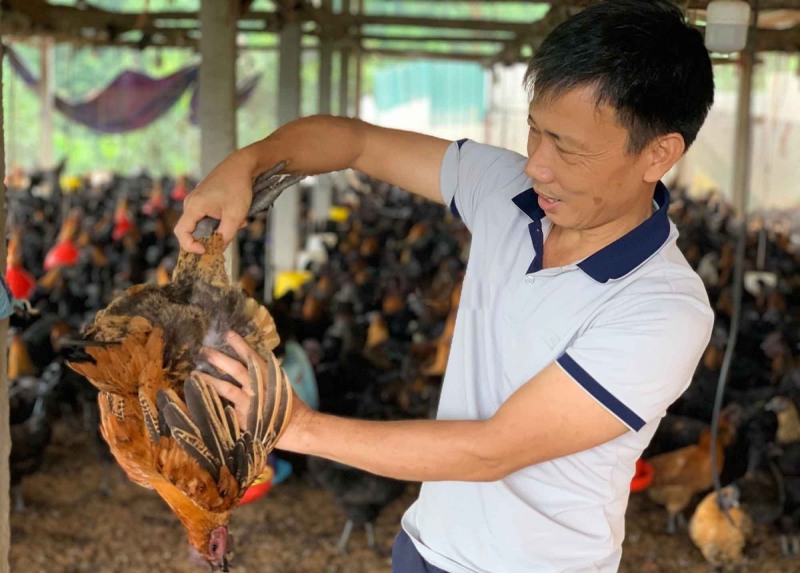Since early August, chicken prices have been rising steadily. A favorable market has allowed farmers to turn a profit after a long period of losses. Joy has returned to many farms as households eagerly expand their operations, restock their flocks, and prepare supplies for the year-end food market.
About six months ago, the price of commercial chicken at farms ranged from only 37,000 to 45,000 VND per kilogram, and at times even lower, causing heavy losses for many households. Now, prices have surged to between 55,000 and 80,000 VND per kilogram, depending on breed and rearing time, bringing significant profits to farmers.

In Xuan Quang commune, the atmosphere in chicken farms has become much busier. Bags of feed are being carried into barns, feeding troughs are constantly refilled, and the lively clucking of chickens signals a bountiful farming season ahead.
Ms. Vui Thi Thuy’s family is currently raising over 7,000 chickens, mainly hybrid breeds. She spends nearly all her time in the barns each day, checking the flooring, rice-husk bedding, feeders, and cleaning the area. Vaccinations are administered on schedule, from five days old to over a month, ensuring the flock stays healthy as they enter the fattening stage.
Ms. Thuy shared: “Back in February, our family sold 7,000 chickens at only 37,000 VND per kilogram, losing nearly 500 million VND. The most recent batch sold for 55,000 VND per kilogram, earning us about 200 million VND in profit. Last year, prices stayed low for so long, farmers really struggled. Now that prices have gone up, I’ve started a new flock to prepare for the year-end and Lunar New Year market. I just hope prices remain stable so we can make up for past losses.”
The optimism is not just Ms. Thuy’s. At the farm of Mr. Phan Nhat Quang – Director of Xuan Tien Livestock Cooperative – operations are running at full capacity with 50,000 chickens. Since mid-2025, the chicken market has improved significantly, with prices staying high and stable for months.
Mr. Quang explained: “We mainly raise Ri-hybrid and No.1 Mia chickens. Right now, Mia No.1 is selling for 78,000–80,000 VND per kilogram and sells out as soon as it hits the market. Ri-hybrid and Ho chickens are priced around 60,000–62,000 VND per kilogram. Compared to early this year, prices have increased by about 25,000–30,000 VND per kilogram.”

Currently, the Xuan Tien Livestock Cooperative has five members, maintaining a total flock of over 80,000 chickens per cycle, with two production cycles per year. The cooperative is strengthening partnerships with businesses and wholesale markets to secure stable outlets and reduce price risks.
Xuan Quang commune is a locality with strong advantages in poultry farming, with a total flock of more than 870,000 birds. The commune now has over 200 medium-scale farms and household operations, developing in a more concentrated direction and applying biosecurity procedures to improve efficiency and minimize disease risks.
According to experienced poultry farmers, chicken prices in the coming period are expected to remain relatively stable as supply and demand are currently balanced. However, many remain cautious, suggesting that restocking should be done in phases rather than all at once during the Lunar New Year season to avoid oversupply risks. Analysts point out that the recent price increase stems from the sharp decline in late 2024, when many households were hesitant to restock, reducing overall supply. At the same time, stricter controls on unsafe food and undocumented imports have created more favorable conditions for domestic livestock products.
Statistics from the provincial Department of Agriculture and Environment show that the total poultry population in the first nine months of 2025 reached more than 13 million birds—nearly 100% of the annual plan and up over 7% compared to the same period in 2024. This growth is attributed to many households converting idle pig barns, left vacant after African swine fever outbreaks, into facilities for raising chickens, ducks, and geese, thereby maintaining stable income sources.
Meanwhile, disease prevention measures have been implemented aggressively. Many localities regularly disinfect farms and have distributed more than 20,000 liters of chemicals to combat avian influenza. Thanks to effective disease control, the province’s livestock sector is gradually recovering and developing steadily. Many farmers have invested in upgrading barns, applying biosecurity practices, and focusing on breed quality and nutrition to improve productivity and meat quality.
As year-end approaches, poultry consumption demand typically rises, especially during the Lunar New Year holiday. Local authorities are directing farmers to prepare sufficient supply to meet market demand while keeping prices stable. Nevertheless, the agriculture sector also warns farmers to carefully calculate their production and avoid expanding too quickly without secured consumption contracts.
The rise in chicken prices not only brings profit to farmers but also creates jobs and helps stabilize the rural economy. If the market remains stable and disease prevention continues effectively, the province’s poultry industry is expected to enjoy a successful season, ensuring a safe and abundant food supply for consumers during the year-end and Lunar New Year period.
Kim Thoa
Source: Lao Cai Newspaper
